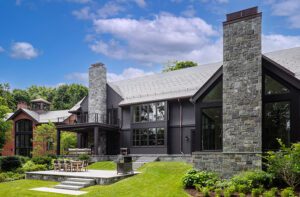A Higher Calling: Artist Alex MacLean
July 19, 2016
Besides being artful, beautiful, and intriguing, Alex MacLean’s aerial photographs sound a clarion call about humanity’s impact on our planet.
Text by Robert Kiener
Stunning. Breathtaking. Mesmerizing. These are just a few of the words that have been used by art critics and fans alike to describe Massachusetts-based photographer Alex MacLean’s unique body of work. After more than forty years of shooting strikingly beautiful scenes from out the windows of small planes and being honored with scores of photography awards and one-man shows, he has become, as the UK’s Daily Telegraph newspaper recently noted, “one of the world’s greatest aerial photographers.”
“That’s flattering,” says the soft-spoken, widely collected photographer as he sits in his comfortable Lincoln, Massachusetts, studio. “But I’d really be satisfied if my photography pleases people and, just as important, makes a difference.”
Collectors are drawn to the incredible variety of geometric shapes, patterns, landscapes, and scenes MacLean shoots rom 1,000 feet in the air. His artistic eye has captured the elusive beauty in everything from neatly patterned fields of wheat to people crowding a Cambridge poolside to scores of lobster boats floating lazily in the waters off Maine. His photographs are in collections ranging from Chicago’s Museum of Contemporary Photography to Dartmouth College’s Hood Museum to Paris’s Centre Georges Pompidou.
MacLean’s work is valued for its content as much as its form. He focuses on the world’s ever-changing landscape and has made a point of capturing images that reflect emerging social and environmental issues such as urban blight, sprawl, pollution, clear-cutting, climate change, and more. As the noted environmentalist Bill McKibben wrote in his introduction to MacLean’s book OVER: The American Landscape at the Tipping Point, “Alex MacLean’s pictures are an irreplaceable document bearing testimony to the precise forces now undermining our only planet. May they help give us the insight to make the changes that we must.”
MacLean trained as an architect at Harvard and worked as a landscape architect before he became a full-time aerial photographer. “I earned my pilot’s license and started photographing for architects and planners who needed aerial photos of their projects,” he explains. After his business picked up he bought his first plane, a Cessna 172, and began shooting his own artistic and personal photographs in addition to his commercial work. “It didn’t take me long, as I looked at the landscape across the country, to realize that in many cases man’s intervention was damaging nature. Some of my photography took on an activist intent,” he says.
Many of these photographs that document this impact on nature have been featured in the eleven books he has published over the years. He explains that he often “fits in” these personal photography sessions during commercial assignments. “There is a lot of chance discovery when I’m flying,” says MacLean. “You often can’t anticipate when or where you will see a striking image, so I am always looking for the unexpected.”
His 2006 book, The Playbook, is a collection of photographs he took of “play-oriented” places—from amusement park rides to hotel pools to baseball stadiums—that he came across while working on other assignments.
The idea for another book, Up on the Roof: New York’s Hidden Skyline Spaces, was conceived when MacLean was flying over the city to document the redesign of Brooklyn Bridge Park. “I was amazed by the variety of things that I spotted on roofs, from basketball courts and swimming pools to putting greens to a one-acre organic farm on an office building.” He came back time and time again over nearly two years to a one-acre organic farm on an office building.” He came back time and time again over nearly two years to document these secret rooftop spaces—what he calls “the fifth facade”—for his 2012 book.
One of the biggest rooftop surprises? The roof of the Museum of Modern Art boasts a massive black, white, and turquoise Picasso-like design in crushed, recycled glass and rubber mulch. Because the roof garden is closed to MOMA visitors, only the museum’s high-rise neighbors can enjoy the view.
MacLean’s future plans include scouting New England for examples for an environmental project that will illustrate agricultural best practices. “There are great examples of the farm-to-table movement, carbon sequestration, and urban farming all over this region,” he says. “I have a lot more flying and photographing to do.” •
editor’s note: Alex MacLean is represented in New England by the Miller Yezerski Gallery, Boston, (617) 262-0550, milleryezerskigallery.com. To see more of his work, go to alexmaclean.com.
Share
![NEH-Logo_Black[1] NEH-Logo_Black[1]](https://b2915716.smushcdn.com/2915716/wp-content/uploads/2022/08/NEH-Logo_Black1-300x162.jpg?lossy=1&strip=1&webp=1)















You must be logged in to post a comment.